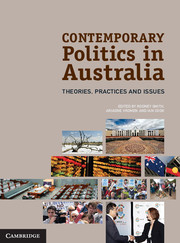Book contents
- Frontmatter
- Contents
- Tables and figures
- Contributors
- Acknowledgements
- Introduction
- I Contemporary Theories of Australian Politics
- Introduction to Part I
- 1 Democratic theories
- 2 Institutionalism
- 3 Behaviouralism
- 4 Critical theories
- 5 Discourse theories and post-structuralism
- 6 International political theories
- Part II Politics in Everyday Australian Life
- Part III Elections
- Part IV Participation and Representation
- Part V Inside the Australian State
- Part VI Contemporary Public Controversies
- Glossary
- References
- Index
6 - International political theories
from I - Contemporary Theories of Australian Politics
Published online by Cambridge University Press: 05 June 2012
- Frontmatter
- Contents
- Tables and figures
- Contributors
- Acknowledgements
- Introduction
- I Contemporary Theories of Australian Politics
- Introduction to Part I
- 1 Democratic theories
- 2 Institutionalism
- 3 Behaviouralism
- 4 Critical theories
- 5 Discourse theories and post-structuralism
- 6 International political theories
- Part II Politics in Everyday Australian Life
- Part III Elections
- Part IV Participation and Representation
- Part V Inside the Australian State
- Part VI Contemporary Public Controversies
- Glossary
- References
- Index
Summary
This chapter addresses a central question for Australian political science: can political scientists use the same theories to explain Australian domestic politics and Australia’s international activities, or do they need different theories to understand each sphere? As the chapter shows, the answer depends to some extent on which theories political scientists adopt to explain domestic and international politics. Realists, for example, point to the absence of a world government to claim that the fundamental problem of international politics – anarchy – is different from the problems raised by domestic political systems with legitimate governments. On the other hand, as a comparison of this chapter with Chapters 4 and 5 will show, Marxists, feminists and discourse theorists use many of the same concepts and approaches to understand domestic politics and international politics. The connections between liberal international relations theory and institutionalism (Chapter 3) will also become obvious to careful readers. Finally, this chapter reiterates the point, made in Chapter 1, that many domestic policy issues are affected but not determined by international power relations.
- Type
- Chapter
- Information
- Contemporary Politics in AustraliaTheories, Practices and Issues, pp. 56 - 68Publisher: Cambridge University PressPrint publication year: 2012



